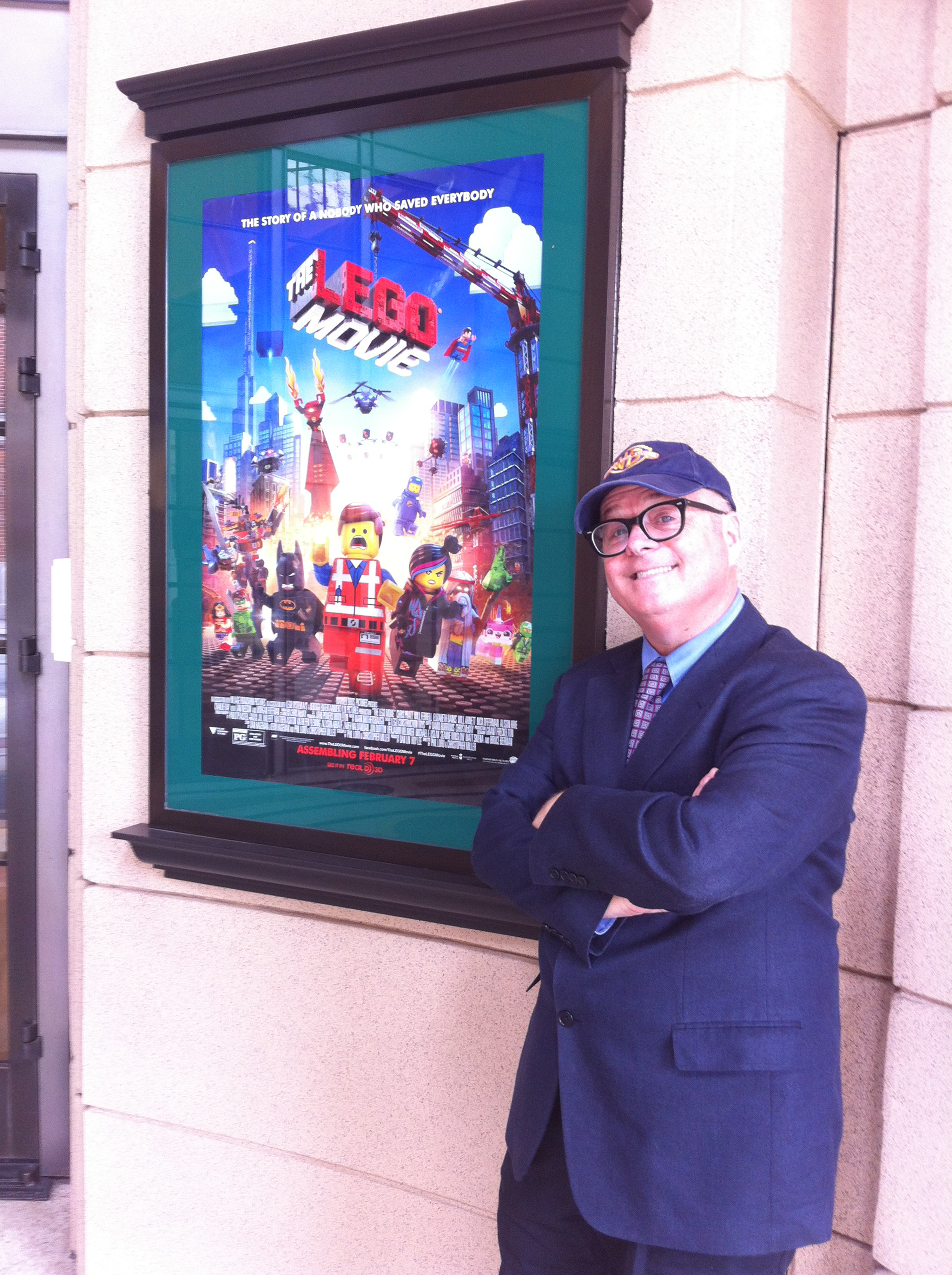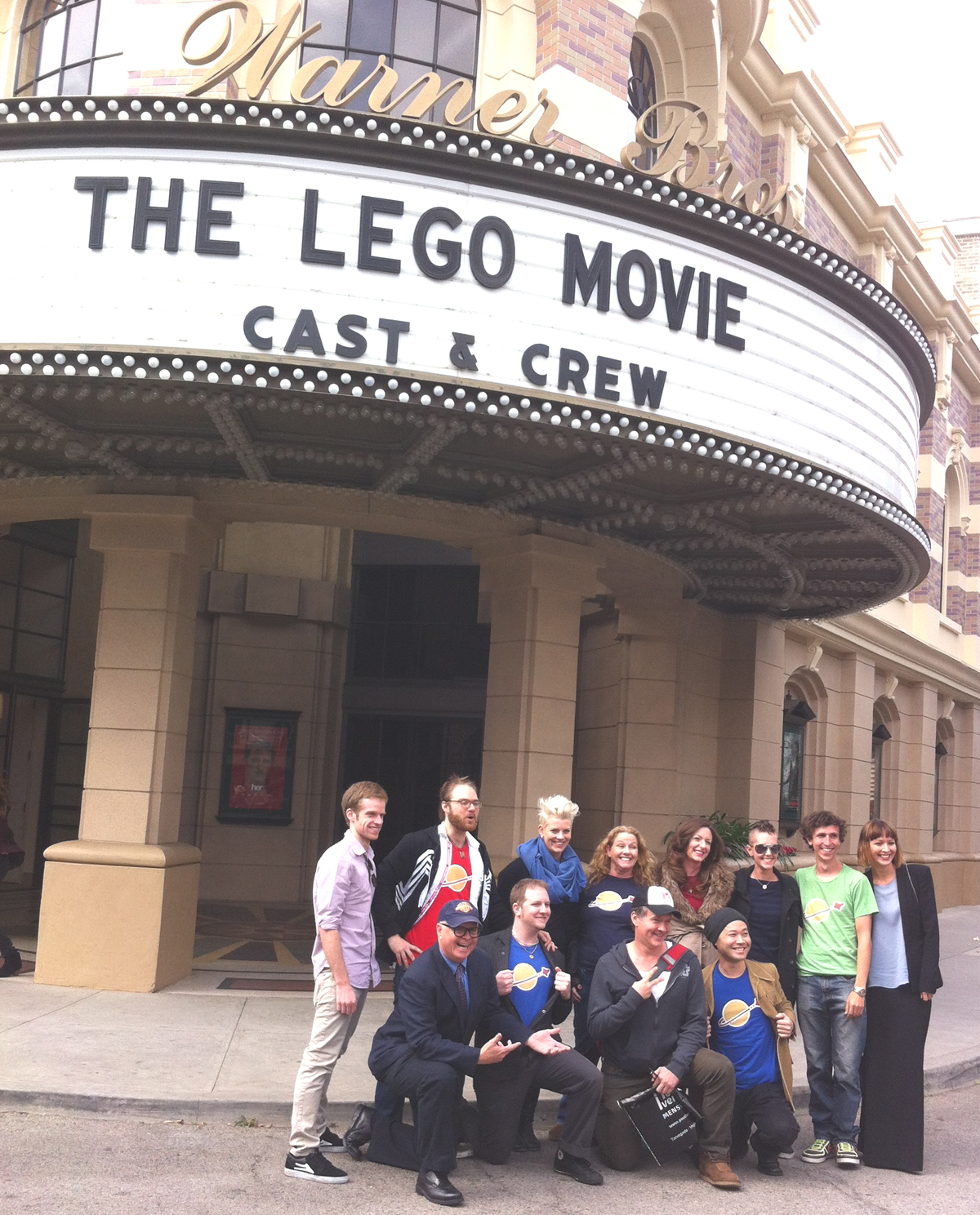
KEN MITCHRONEY, a storyboard artist on “The LEGO Movie,” is a Martinez resident.
Donna Beth Weilenman/Staff
New animated feature boosted by Bay Area talent
By Donna Beth Weilenman
Staff Reporter
Before the public gets to see “The LEGO Movie” when it opens Friday, those who worked on the film and their families celebrated the upcoming theatrical release at a special showing Sunday at the Warner Bros. Studios lot in Burbank.
Among them were two men from the Bay Area, one from Martinez and the other formerly of Moraga.
Todd Hansen, who lived in Moraga until moving to the Los Angeles-Hollywood area six years ago, did more than edit animation for “The LEGO Movie.”
He also inspired a gag that became a key plot point.
Hansen said he hadn’t expected it to be a joke when it came up in conversations during meetings encouraged by animation director and editor Chris McKay.
In fact, he said, he saw it as a solution to his limited living space.
When crew members were asked what they had done during a particular weekend, Hansen described the construction project he had completed after three weeks: A double-decker couch designed to provide extra space for friends to watch television.
The rest of the crew proclaimed it “one of the dumbest things” they’d heard.
Despite the panning from his colleagues, Hansen defended the unusual piece of furniture. Meanwhile, the teasing continued.
Then, as work on the movie progressed, the couch was incorporated into the storyline.
And while the LEGO characters in the film also made fun of the idea, the bi-level couch at one point became key to their survival.
Another Bay Area artist associated with the movie is Martinez resident Ken Mitchroney, who spends much of his career at Southern California studios.
Mitchroney worked part of 2011 and most of 2012 as a storyboard artist on the movie.
One of his major segments comes early in the film after the introduction of lead character Emmet Brickowoski, voiced by actor Chris Pratt.
Mitchroney’s sequence begins once Emmet is in his car and the song “Everything Is Awesome” comes on the radio.
He worked extensively with the LEGO Batman, voiced by Will Arnett, one of the dominant figures in the story.
Mitchroney also staged a shipbuilding sequence that takes place toward the end of the film.
He was brought in to the project after McKay interviewed him online in Martinez, and the two men found they had similar film style sensibilities.
Mitchroney said the movie’s leaders encouraged collaboration, and they listened to crew members’ ideas, such as the use of Hansen’s couch as a plot point.
“We voted on (Wyldstyle’s) look,” he said, speaking of the female lead character who works with Emmet and is involved with Batman. Several designs were presented, and the directors supported the crew’s decision.
“They let us get our hands in it,” Mitchroney said, adding that that approach resembled the way Pixar worked in its earlier days.
Mitchroney worked at Pixar on “Toy Story 2” and “Monsters, Inc.”
The producers and directors also encouraged play, he said. Employees not only engaged in plenty of foosball, they also staged Nerf weapon wars between the story and editing departments.
Directors not only didn’t mind the horseplay, they joined in, often supporting whichever side was failing in that day’s battle.
And, of course, employees played with LEGOs, too.
In fact the studio received boxes of LEGOs, and employees were urged to start building with them. Mitchroney built a car, and had it signed by his coworkers.
Staff also researched at LEGOLAND theme park in San Diego, he said, where crew members took photographs and explored the shops where toys and displays are built.
Once concept drawings were made for the movie, they were given to LEGO, Mitchroney said. The toy company then built many of the sets, characters, machines and vessels using the popular tiny plastic constructible blocks on which the movie is based.
That helped the computer graphics modelers and the story crew, because it allowed them to see how the constructs looked in three dimensions, Mitchroney said.

THE CAST AND CREW OF “The LEGO Movie,” back row from left, Todd Hansen, Chris Paluszek, Seanne Winslow, Theresa Cullen, Kelly Lafferty, Lizzie Sam, Doug Nicholas and Natasha Gubareva; front row from left, Mitchroney, David Tuber, Chris McKay and Yori Mochizuki.
Donna Beth Weilenman/Staff
The movie itself is a collaboration of several studios. An Australian studio, Animal Logic, handled animation production; Warner Bros. is the distributor; and Legend3D transformed the film into a stereo three-dimension product. Other key roles were played by Village Roadshow Pictures, Vertigo Entertainment, Golden Village Pictures, InterCom, SF Film Finland and Lin Pictures.
Mitchroney had praise for producer Dan Lin and executive producer Seanne Winslow of Lin Pictures, who helped the movie makers better understand LEGO tie-ins to other media characters.
For instance, LEGO fans can assemble sets and characters from such varied movies as “Star Wars” and “Pirates of the Caribbean.” To help her crew understand the toys’ source materials, Winslow brought in individuals who had contributed to those movies, and they shared stories and answered questions.
For Mitchroney, a particular thrill was getting to visit the Warner Bros. movie lot.
Across the street from where Sunday’s movie showing took place is Warner’s “Old New York” street, with buildings used in movies featuring such stars as Humphrey Bogart, Edward G. Robinson, Errol Flynn and James Cagney.
A classic movie buff, Mitchroney can cite the movies, even individual scenes, where filming took place at different areas of the lot.
But he’s not limited to the vintage eras. He also can point out the places where more recent movies have been directed by Clint Eastwood, and where Dr. Sheldon Cooper stands during certain scenes in the television show, “Big Bang Theory.”
So Mitchroney wasn’t disappointed that the cast and crew showing of “The LEGO Movie” on Sunday didn’t involve a red carpet and a limousine ride to one of Hollywood’s classic movie palaces, and instead took place at Warner Bros. Studios.
“For me, it was special to see it on the lot,” he said.
Phil Lord, who with Christopher Miller directed “The LEGO Movie” and wrote the screenplay, told his crew Sunday, “I’m very excited about the screening.” Miller had another commitment that day — he attended the Super Bowl in East Rutherford, N.J.
While Lord called the crew the “wizards” who made the film, he recognized that instead of genius, it was the hard work they had put in during three years before the movie’s release that made the final product so special.
McKay said he is proud of the film and the work of the crew, and said it is far from a studio gambit to make money from an established commercial success. “It could have been the most cynical cash grab,” he said.
Instead, he spoke about the film’s heart, and explained that those involved at every level showed they cared about the movie — and the modeling blocks that have become a staple of so many childhoods.
“They made real characters,” he said, “and the movie works.”
He told the crew they “made something that lives and breathes and pops off the screen.”
Mitchroney agreed, saying the movie’s approach remains close to the way children actually play with the toys.
For instance, the on-screen textures — for example clouds, water drops from a shower and heaving ocean waves — are made of computer-generated LEGO blocks, not just characters and their vehicles.
The human characters, he said, ride horses that move as if a child’s invisible hand were rocking plastic equines back and forth. Planes, ships and space craft — even some plundered replacement body parts — are based on LEGO blocks.
“It’s all LEGOs. That’s the purity of it,” Mitchroney said. “That’s what’s going to connect with everybody who messed with LEGOs.”






Leave a Reply